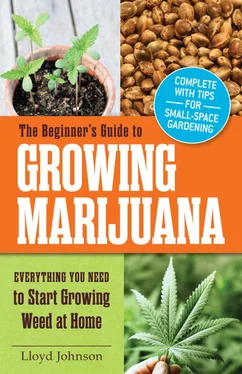You should plan on two to four weeks for cuttings to root and become actual little plant clones. Until then, keep their light relatively cool; fluorescent light is suitable. They need warmth, but not hot, bright light just yet.
If you have started from seed, and are not using feminized seed, you will be dealing with twice the amount of little plants than you want to end up with in your flowering phase. This is because cannabis is dioecious, and must declare for the grower to know if the plant is male or female.
The first transplant for seedlings is usually from their little four-inch starter pots to a three- or five-gallon container. This will allow enough room for the plants to grow while they make their sexual determination. Unsexed seedlings can also be each allotted a two-gallon pot until they declare their sexual identities; this will not hurt them, though it may limit their final size. This is not necessarily a bad thing in an enclosed and finite space, and it has the added benefit of making it easier to move the males once you know which ones they are.
How to Transplant
Have the next size containers ready to go, filled partly with your prepared soil. Leave a hole a few inches deeper and wider than the transplants’ current containers. You can check how much initial soil to put in the container by setting the plant in its existing pot inside and checking that you have left enough room for the incoming root ball.
Water the waiting soil, and stir to make certain it is uniformly dampened; check that the water drains well from the container. Scratch in a handful of bone meal; this will be easily accessible to the plant’s roots and will aid in strong root production. Let the soil of the plants waiting for transplant get slightly dry; soil that is too wet will be heavy and has the potential to fall apart, breaking the root ball.
One person can easily perform early transplants. When the plants are taller and in heavy larger containers, you need a transplanting assistant to help you pull the pots. It will also be easier on you, particularly your back, to have a transplant pal. Remember, to get the plant out of the pot, you are going to be turning it over and using gravity to slide the root ball out. If you are not particularly strong or tall, a helper is essential. Root balls also do not always slide right out, and wrestling a heavy, earth-filled container while trying not to break the plant can get tricky and tiring.
Sometimes, despite all best efforts, a root ball will break. While this event is not ideal, do not panic; cannabis is a very strong plant. The plant will spend a little time adjusting its root growth and get back to strong vegetative growth; the root damage just puts it a little behind the schedule of its sisters.
Once the transplant is settled gently in place, fill in with your prepared soil and gently press around the plant’s main stem with the flat palms of your hands. This will help bring the roots in contact with the soil. Water gently and press again to settle the plant. Make certain the plant’s identifying label or tag is secured or written on the side of the container with indelible pen.
Keep It Simple
If you are using a helper, always make certain that you both understand the plan in advance—who is pulling the pot, and who is supporting and turning the plant. Otherwise, confusion can lead to broken plants or root balls. As soon as the pot-puller frees the root ball, he can quickly set the pot down and help support the root ball until it is settled gently into its new container.
Lights and Your Transplants
Once you have your little plants transplanted, you will want your grow room lights to cycle for the vegetative phase. Make certain the plants get eighteen-hour “days” and six-hour “nights” for two full weeks. If you are using HID, place the young plants so they are twenty-four to thirty-six inches from the light source. If you have concerns about burning the plants, hold your own hand under the light where the tops of your plants will be; if it burns you, it will be burn them. You may need to adjust the light height up or down as you observe the plants. If they are getting “leggy,” they are reaching too much, and the lights need to be lowered. Keep an eye on your lights. The plants are growing very rapidly, so be alert and prepared to adjust the height as often as needed.
If you are working with clones, they should be one to two feet tall by the seventh week in vegetative phase. At this time, you can change your light cycle to a twelve-hour day and twelve-hour night to induce flowering, or move the clones to a separate flowering room with this light cycle on timers. This is the time to switch to lower nitrogen and to feed for bloom.
Rotating Vegetative and Flowering Cycles
If you are working with seedlings, give an extra four weeks of growth in the vegetative phase before inducing flowering. This is where having separate vegetative and flowering rooms can give you more options. This setup also allows for continual cycling of vegetative and flowering plants. As soon as one crop is harvested and the flowering room deep cleaned, another group of vegetative plants can be installed and induced to flower. The vegetative room can also be cleaned and then can begin another cycle of young plants for a perpetual growing cycle.
Fertilizing for Vegetative Growth
Once your cuttings or seedlings are well started, the plants will enter their vegetative phase of growth. They are working at growing roots and gaining size, building strong stems and lots of healthy green leaves. During this phase the plants will need plenty of water and a great deal more nitrogen than during the flowering phase.
Organics rarely burn plants, but testing your soil and understanding the different properties of different organic amendments can, along with your budget, help you choose wisely. Packaged amendments generally list nitrogen, phosphorus, and potassium in that order.
Blood meal applications last up to four months and should be used with caution (outdoor growers use no more than four ounces per square yard during the growing or vegetative phase). Indoor growers are more likely to use it as an element in tea for their plants as dilution with water makes it less likely to burn tender young plants, and it is a good source of nitrogen.
As long as your plants are in a vegetative phase of growth, they will use a lot of nitrogen and push to grow big and leafy. Watch each plant as an individual, and feed a “power drink” of special compost or manure tea once a week. This can coincide with the plants’ watering schedule for convenience.
Fertilizing for Flowering
As the plants start to flower, their vegetative growth will slow and then stop. The grower should stop feeding high nitrogen; the plants will need more phosphorus and potassium for flowering. If you are using premade organic supplements, look for a ratio of approximately 15-30-30 for flowering.
The plants will also need calcium, which you can supply by scratching finely ground organic eggshells into the soil around the main stem. An electric coffee grinder can be used to prepare the eggshells, but wear a mask, as the fine powder is easy to inhale.
Every indoor grow room should have a thermometer and a hygrometer installed, because accurate measurements are essential for maintaining a healthy plant environment. Ideally, you will use a thermometer that not only shows current temperature but records the high and low measurements for each day. This will give you valuable information as to how well your cooling and venting systems are working. The ideal temperature for an indoor grow is 72°F–76°F. The best range in relative humidity is from 60–70 percent for vegetative plants, dropping to 40–60 percent during the flowering phase.
Читать дальше












